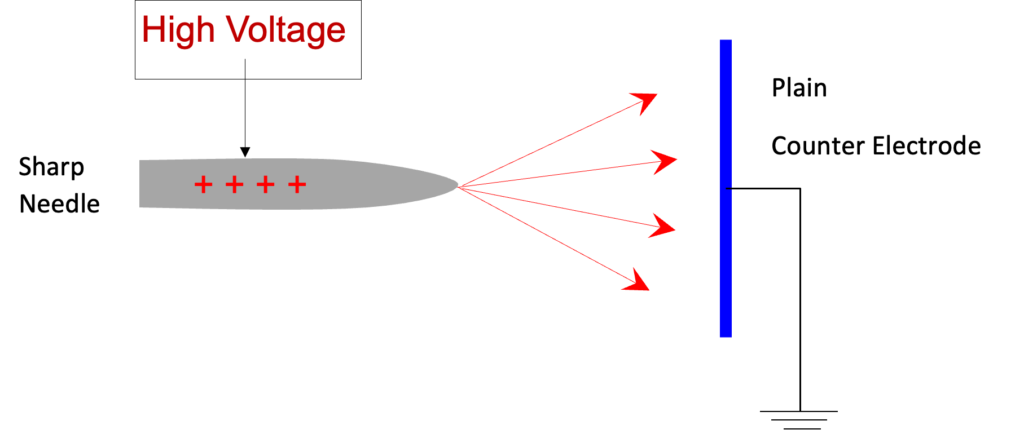Ion Source in IMS
The conventional ionization source in most ion mobility spectrometers is radioactive 63Ni which generates beta ray for ionization. Other radioactive isotopes such as Tritium and 241Am have also been used in IMS. Despite the simplicity, providing stable and reliable operation, and no need for external power and being maintenance-free, radioactive ion sources are associated with difficulties including regulatory and financial issues, as well as technical limitations. The following limitations discourage user from having IMS with a radioactive source.
- Special permits and licensing procedures are required, to have radioactive ion sources in place.
- Periodic checks for leakage of radioactivity and general laboratory hygiene are required that costs and discourage users.
- Elevated temperatures in the air may eventually cause oxidation of the source that may release radioactive particles into the ambient environment.
- Reacting chemicals in drift tube such as Cl and H2S end up formation of salts, even at low temperatures, that may cause the same effect.
- When the use of the instrument ends the radioactive source cannot be simply disposed. The disposal costs and requires special permits.
A common alternative ionization source used in some IMS-based instruments is the ultraviolet (UV) photoionization source. However, the performance of UV lamps deteriorates over time, with their lifetime limited to several months of continuous operation.
Detect Ion Company is proud to be the pioneer in the successful use of corona discharge as an ionization source in Ion Mobility Spectrometry. We developed the first stable DC corona discharge for IMS followed by the negative discharge in nitrogen and air. The characteristics of the corona discharge used by Detect Ion are stability, long lifetime with no corrosion, and no need for regular maintenance, unlike radioactive ion sources. It can operate at elevated temperatures that reduces the memory effect which is essential for non-volatile compounds. The corona discharge can be used without fear of chemically reacting samples, especially detecting acids and corrosive gases such as Cl and H2S.
Detect Ion, a pioneering company, takes pride in successfully utilizing corona discharge as an ionization source in Ion Mobility Spectrometry. We have developed the first stable DC corona discharge for IMS, followed by the implementation of negative discharge in nitrogen and air. The key characteristics of the corona discharge employed by Detect Ion include:
- Stability, RSD < %2
- Long lifetime with no corrosion, several years.
- No need for regular maintenance.
- Operating at elevated temperatures, which is crucial for detecting semi-volatile compounds and reduces memory effect.
- Can be used for detecting chemically reacting samples such as acids and corrosive gases like Cl and H2S.
Corona discharge Ionization Source
Corona discharge (CD) is one of several types of electric discharges that occur in a strongly nonuniform electric field, which is typically insufficient for electrical breakdown. This phenomenon is observed when the size of the electrode is much smaller than the distance between the electrodes. A classic example of this is the point-to-plane geometry, as illustrated in above, where a needle is positioned a few millimeters away from a flat plate. In this setup, a high voltage is applied to the needle while the plate, or counter electrode, is grounded. This configuration results in an extremely nonuniform electric field, with the strongest intensity at the tip of the needle. The needle can be charged with either a positive or negative high voltage, giving rise to positive or negative corona discharge, respectively.

The mechanism of corona discharge is dependent on the polarity of the electrode surrounded by the corona. In the case of negative CD, the discharge begins by attracting a few background positive ions that naturally exist in the surrounding air. The strong electric field accelerates these ions toward the tip of the needle, causing them to impact the surface and eject electrons. These ejected electrons then move in the opposite direction away from the tip, with very high speed, colliding with air molecules and generating more electrons and ions. This process rapidly escalates into an avalanche of electrons and ions. The discharge is sustained because positive ions accumulate around the tip of the electrode, reducing the effective electric field.
In the case of positive discharge, similar phenomena occur, but with a notable difference. Positive point electrodes cannot generate electrons on their own; instead, electrons are produced by the impact of electrons or ions on neutral molecules present around the needle. As a result, forming a positive corona is more challenging than creating a negative corona.
Overall, corona discharge is a fascinating electrical phenomenon that occurs in nonuniform electric fields, and its behavior depends on the polarity of the electrode at the center of the corona.